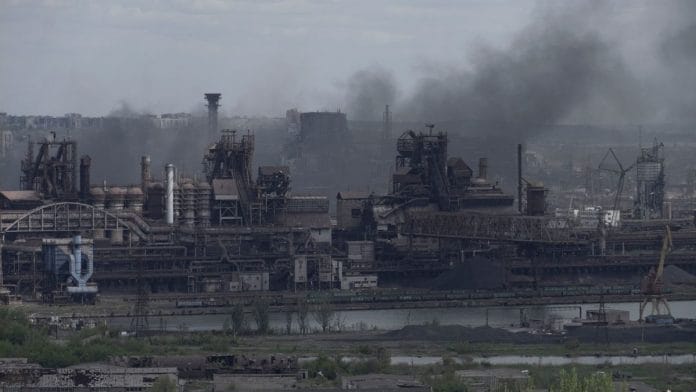New Delhi: Days before the Ukrainian army surrendered control of the Azovstol steel plant in Mariupol Monday, Russian forces had attacked it with explosives known as white phosphorous bombs.
A video circulating online shows a whiff of smoke and fire engulfing the plant, as Russian forces launched brightly burning munitions onto the besieged and dilapidated steel plant.
⚡️⚡️Urgent! Azovstal is being bombed with phosphorous bombs#UkraineUnderAttack #SaveAzovstal pic.twitter.com/aSGo0b4QCF
— Anton Gerashchenko (@Gerashchenko_en) May 15, 2022
This isn’t the first-time that reports of Russian forces using white phosphorous bombs — since the conflict began — have emerged.
Ukraine had accused Russia of using phosphorous bombs
in March. Ukrainian President Volodymyr Zelensky had told a NATO summit that Russia was committing war crimes by using phosphorous bombs against civilians.
Many other reports from Roubizhne in Luhansk and Irpin near Kyiv in Ukraine had also accused the Russians of using these hazardous munitions.
The Times had reported: “In April, British defence sources said white phosphorous bombs had already been used in the Donetsk region.”
Reacting to Russian forces bombarding the Azovstol plant Sunday, Petr Andryushchenko, an advisor to the mayor of Mariupol, said, “The combustion temperature is about 2,000 to 2,500 degrees Celsius. It is almost impossible to stop the burning.”
ThePrint unpacks what these white phosphorous bombs are, how dangerous are they and the international conventions around them.
Also read: Russia prepares for Severodonetsk battle as Ukraine lines up counteroffensive near Izyum
What are white phosphorous bombs
Phosphorous is a wax-like chemical compound that is usually yellow or colourless and smells like garlic. It is highly inflammable when exposed to oxygen.
This ignition triggers a reaction that disseminates heat of about 815°C and heavy white smoke.
For tactical and strategic purposes, militaries use them to create diversions, conceal troop movements and light up dark stretches.
At times, these bombs are also used to target civilians and civilian structures. Apart from direct injuries caused by shells of the munitions, white phosphorous bombs can also cause grave harm through burns and vapour inhalation.
Can ‘burn people to the bone’
According to a recent Human Rights Watch report, white phosphorous bombs can cause severe injuries to humans. “White phosphorus can burn people to the bone, smoulder inside the body, and reignite when bandages are removed,” the report states.
Scholars David Barillo, Leopoldo Cancio, and Cleon Goodwin, in the Burns Journal, explain that as white phosphorous bombs cause burns that can damage bones, they form deep wounds which take much longer to heal than regular burns.
In essence, these bombs make the body vulnerable and weak for a long time, increasing the chances of other infections and diseases.
An article in the Disaster and Military Medicine Journal explains that a 10 per cent total body surface area burns from white phosphorous bombs can cause immediate death.
A further testament to its lethal nature is that white phosphorous bombs can accumulate and stick to an individual’s body, causing harm over a long period, as it can reignite when exposed to oxygen.
International conventions
White phosphorus bombs are, however, not classified as chemical weapons and hence not banned. The use of chemical weapons has been prohibited by the Convention on the Prohibition of Chemical Weapons since 1997.
White phosphorous bombs are categorised as incendiary weapons. Their use is codified by Protocol III in the Convention on Certain Conventional Weapons (CCW), signed in Geneva and enforced since 1983. Their usage against civilians and civilian structures is prohibited by Protocol III.
However, the protocol has legal loopholes that prevent its complete implementation or effective containment.
These loopholes relate to the definition of incendiary weapons. The definition excludes those that can be of multipurpose usage and it imposes weaker restrictions for those launched from the ground.
This has led to continued calls to strengthen Protocol III and ban the usage of white phosphorus bombs.
Also read: People with disabilities in Ukraine facing crisis within crisis. Human aid should take note






